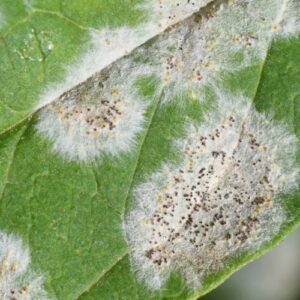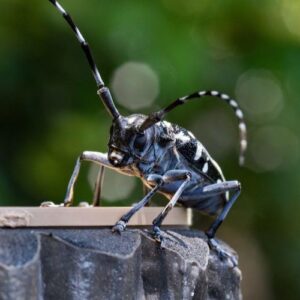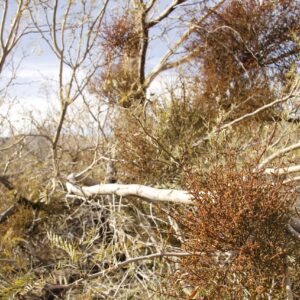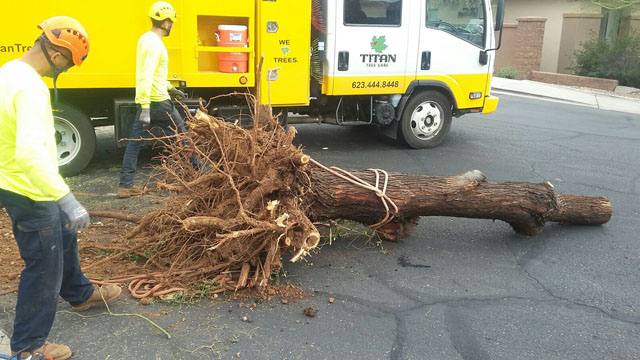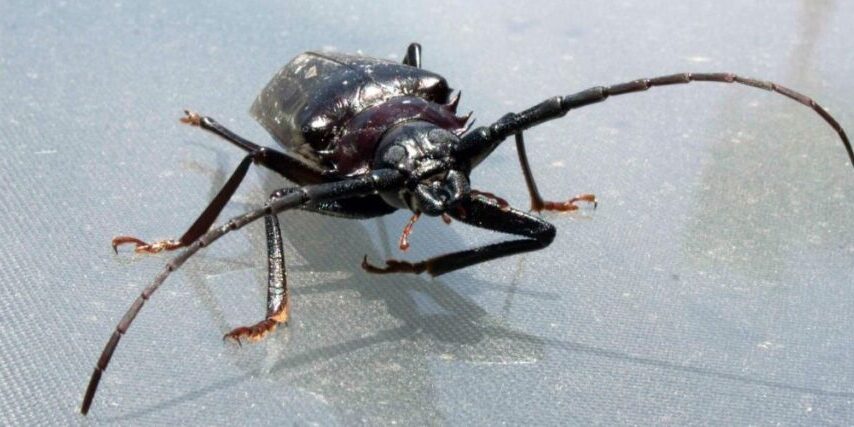
Summer in Phoenix means two things: monsoons and many large bugs. If you’re a proud owner of a palo verde tree or two (they are, after all, Arizona’s state tree!), you’ll want to keep an eye out for one supersized specimen in particular — the palo verde beetle.
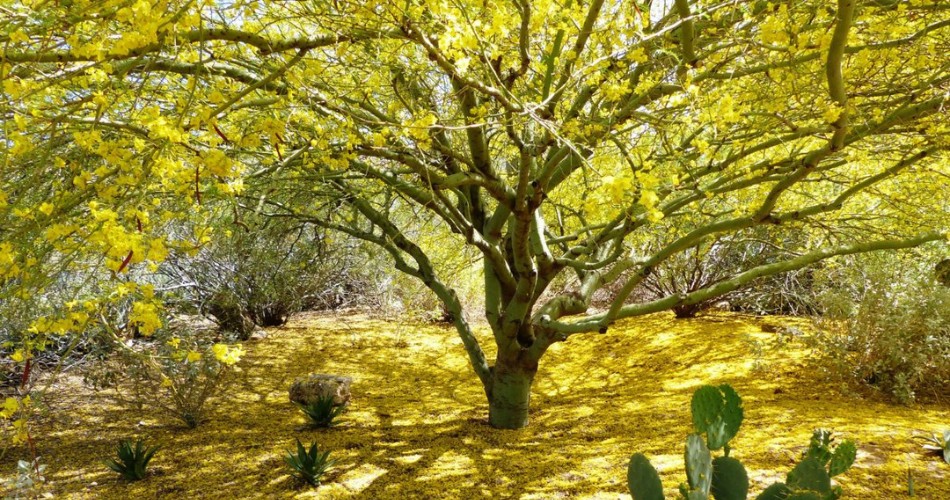
Key Takeaways
- Palo verde root borers (or palo verde beetles) emerge during the summer months when the monsoon season begins and lay their eggs underground at the base of palo verde (and other broadleaf) trees.
- These large insects do not bite or pose a danger to people and pets, but their larvae eats away at the tree’s root system, leading to branch dieback and potential death in unhealthy trees.
- The best palo verde beetle treatment and protection plan is to establish and maintain proper tree care to prevent an attack on your landscaping.
What Are Palo Verde Root Borers?
The palo verde root borer is a large beetle found in the southwest region of North America that earns its name from its association with and preference for feeding on the palo verde tree and its cultivars. Like other boring insects, the palo verde beetle spends the majority of its life as a grub (larva) burrowing and eating; but, it’s not the tree itself that they like to munch on, it’s the root system.
Emerging during the monsoon season of summer, these pests exist long enough to startle bug-weary residents, find a mate, and lay eggs in holes around the base of the host tree – usually no longer than a single month. Once they hatch, the real damage begins. Larval palo verde borers begin to eat their way through the roots for the next three to four years, looking for roots big enough to bore through at the center. This hidden damage eventually results in branch-by-branch dieback and possible death in weak or unwell trees.
Adult Palo Verde Beetle Appearance
Commonly confused with a cockroach, the adult palo verde beetle can be recognized by its size. One of the largest beetles in North America, an adult may reach up to three and a half inches long – not including the antennae, which usually measure at least half their body length. But, despite their intimidating appearance, these insects do not have stingers, produce venom, or routinely bite people or pets, unless provoked. Even then, the bite may hurt, but it won’t cause any serious or long-lasting harm.
You’ll notice these large beetles most in late June to early August, especially at dusk. The adult palo verde borers are drawn to lights, so if you want to keep them out of your house, avoid turning on porch lights near exterior doors whenever possible. Because of their large size and hard shell, you may hear them if they run into a door or window near a light source.
Palo Verde Beetle Grub (Larvae) Appearance
In stark contrast to their brown or black adult form, palo verde grubs are a creamy white or greenish color, as thick as a finger, and usually between three and four inches long. After feeding and gathering all the stored energy they’ll need for adulthood, they enter the pupal stage. Here, they rest for several weeks before emerging from quarter-sized holes as a fully formed beetle.
A not-so-fun fact: these beetle larvae may prefer the hearty roots of a palo verde tree from which they get their name, but they’ve also been observed to gnaw through buried PVC pipe, demonstrating their mandible might.
Can Palo Verde Borers Kill My Tree?
Though there are several different pests, diseases, and even tree care practices that can impact palo verde tree health, the most common culprit is the palo verde root borer beetle.
While the adults themselves don’t cause irreparable harm to your landscaping, these large longhorn beetles – officially Derobrachus hovorei; known as the palo verde beetle or palo verde root borer – are more damaging in their larval stage.
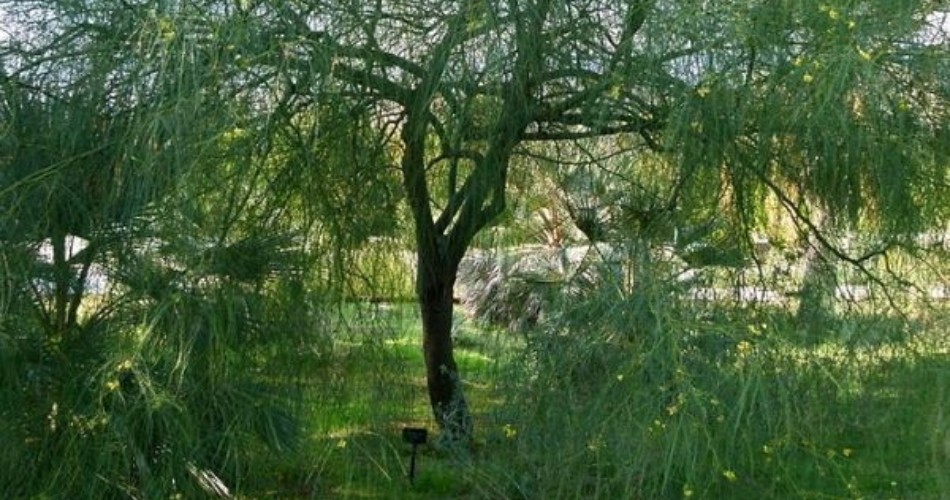
Do Palo Verde Beetles Damage Other Tree Species?
They can, yes. Palo verde borers obviously love all types of palo verde trees and may be partial to the Mexican palo verde. However, they will also eat the roots of other broadleaf (the term for plants with leaves wider than they are long) trees and shrubs such as mesquites, cottonwoods, privets, elms, and even stone fruit trees like peaches, apricots, and plums, among others.
Palo verde borers may have an appetite for a wide range of plants, but there are some species they do not seem to be fond of, including agave, bamboo, palms, and others with parallel veins throughout their leaves. So, if you have recently removed a tree that died due to a borer infestation, you may want to plant one of those in its place.
Signs of a Palo Verde Beetle Infestation
The tricky thing about dealing with a pest like the palo verde root borer is that the damage can go largely unnoticed; the visible damage (above ground) usually appears well after the cause (root damage) has progressed to the point where the entire tree is at risk.
Check your trees for branch dieback, particularly large branches that quickly die right back to the trunk. If one branch dies at a time, one of the first suspects should be palo verde root borers.
Be sure to also check the ground surrounding the root zone for holes that are approximately the size of a quarter; they usually indicate the exit path of the freshly developed adult beetle.
How to Protect Your Trees from Palo Verde Borers & Prevent Them from Coming Back
Palo verde beetles tend to attack trees that are already stressed or exhibiting signs of disease or decline, making prevention the best form of protection.
Healthy and well-cared-for trees have the best chance of withstanding damage caused by insects, diseases, and weather-related trauma. So, when a strong and healthy tree is attacked by palo verde borers, you may never actually see symptoms above ground. Healthy trees can recognize the attack and produce new roots to replace those devoured by the grubs, as well as offset any effects on the tree’s overall health.
However, for an already diseased, injured, or dying tree, these boring insects may speed up the inevitable decline of the plant. In these cases, the best option is to schedule a tree removal service.

When Palo Verde Borers Are Putting Your Tree at Risk, Trust Titan Tree to Protect It
If you suspect your trees or shrubs are suffering from a palo verde borer infestation, consult a tree care professional from Titan Tree Care. Depending on the threat level and sustained damage, we may be able to help with a root drench using a systemic insecticide and can also recommend other solutions to help the health of your trees.
As with most things, prevention is the best cure for a palo verde beetle attack and it’s always better to be proactive as opposed to reactive. Give us a call at 623-444-8448 to schedule your consultation and help your trees remain happy and healthy for years to come.
More Articles Like This

Titan Tree Care is a full-service tree care company located in Anthem, AZ and serving all of North Phoenix. We offer a wide range of services to meet your tree care needs, including tree and palm trimming, tree pruning, tree removal, stump grinding, and more. We also offer insect or disease treatments and fertilization services. We are dedicated to providing high-quality, safe, and effective tree care services to our customers and work hard to ensure that your trees are healthy and look their best.



